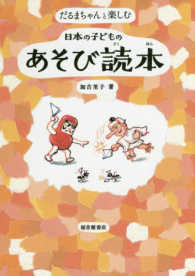- ホーム
- > 洋書
- > 英文書
- > Psychology
基本説明
Presents a coherent view of how infants and children perceive and think about the human body.
Full Description
Because we engage with the world and each other through our bodies and bodily movements, being able to represent one's own and others' bodies is fundamental to human perception, cognition and behaviour. This edited book brings together, for the first time, developmental perspectives on the growth of body knowledge in infancy and early childhood and how it intersects with other aspects of perception and cognition. The book is organised into three sections addressing the bodily self, the bodies of others and integrating self and other. Topics include perception and representation of the human form, infant imitation, understanding biological motion, self-representation, intention understanding, action production and perception and children's human figure drawings. Each section includes chapters from leading international scholars drawn together by an expert commentary that highlights open questions and directions for future research.
Contents
Part I. The Bodily Self: 1. Primordial sense of embodied self-unity Philippe Rochat; 2. The development of body representations: the integration of visual-proprioceptive information Stephanie Zwicker, Chris Moore and Daniel Povinelli; 3. Emergence and early development of the body image Celia A. Brownell, Margarita Svetlova and Sara R. Nichols; 4. Gulliver, Goliath and Goldilocks: young children and scale errors Judy S. DeLoache and David H. Uttal; Commentary Manos Tskaris; Part II. The Bodies of Others: 5. Developing expertise in human body perception Virginia Slaughter, Michelle Heron-Delaney and Tamara Christie; 6. Children's representations of the human figure in their drawings Maureen Cox; 7. Understanding of human motion, form and levels of meaning: evidence from the perception of human point-light displays by infants and people with autism Derek G. Moore; 8. How infants detect information in biological motion Vincent Reid; 9. The integration of body representations and other inferential systems in infancy Kirsten O'Hearn and Susan C. Johnson; Commentary Kazuo Hiraki; Part III. Bodily Correspondences: Integrating Self and Other: 10. Prepared to learn about human bodies' goals and intentions Teodora Gliga and Victoria Southgate; 11. Imitation in infancy and the acquisition of body knowledge Susan Jones and Hanako Yoshida; 12. Infants' perception and production of crawling and walking movements Petra Hauf and Michelle Power; 13. The body in action: the impact of self-produced action on infants' action perception and understanding Jessica A. Sommerville, Emily J. Blumenthal, Kaitlin Venema and Kara D. Sage; Commentary Moritz M. Daum and Wolfgang Prinz.








